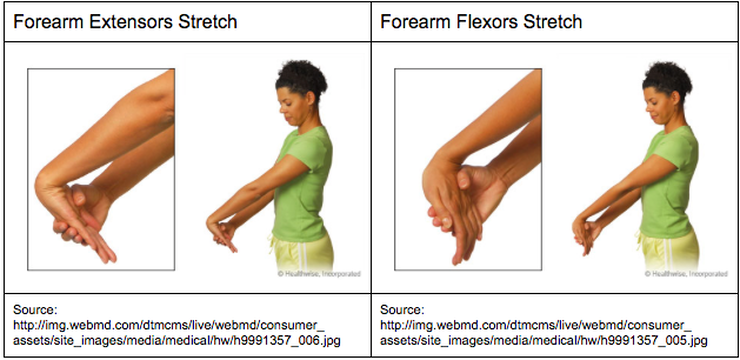
Many people with elbow pain get diagnosed with tennis elbow or golfer’s elbow, and are left confused because they’ve never played either sport!
Read on, and I’ll clear up the confusion, explain why some people get it, and a few things you can do to help it.
What is Tennis/Golfer’s Elbow?
First point of clarification: these injury names are layman’s terms for lateral epicondylitis (tennis elbow) and medial epicondylitis (golfer’s elbow). That didn’t really clarify anything, did it? Here’s a brief anatomy review:

Look at the above picture. Your humerus (upper arm bone), ulna (forearm bone), and radius (also a forearm bone), come together to make up the elbow joint.
The lateral and medial epicondyles are bony protrusions on the distal part of your humerus.
As we learned in the post about the rotator cuff, when a word ends in ‘-itis’, it means inflammation.
So, lateral epicondylitis (tennis elbow) is an inflammation of the lateral epicondyle bone, and medial epicondylitis (golfer’s elbow) is an inflammation of the medial epicondyle bone, right?
Well…. Almost. Here’s a little more anatomy:

The picture on the left above shows the muscles on the back of your forearm.
These muscles are called extensor muscles because they function to extend the wrist and fingers.
The picture on the right above shows the muscles on the front of your forearm. These muscles are called flexor muscles because they function to flex the wrist and fingers.
As you can see in the pictures, most of the extensor muscles (left picture) combine into one tendon, and attach to the lateral epicondyle. This tendon is often called the common extensor tendon.
On the other side of the forearm, most of the flexor muscles (right picture) combine into one tendon and attach to the medial epicondyle. This tendon is often called the common flexor tendon.
So, lateral epicondylitis (tennis elbow) is an inflammation of the common extensor tendon (which attaches to the lateral epicondyle bone), and medial epicondylitis (golfer’s elbow) is an inflammation of the common flexor tendon (which attaches to the medial epicondyle bone),
Right?… RIGHT!
The injury typically occurs in the tendons, the injuries are just named for the bone in which they attach to.
So, here’s the short clarification: pain due to inflammation of the tendons on the outside of your elbow is called tennis elbow (lateral epicondylitis).
Pain due to inflammation of the tendons on the inside of your elbow is called golfer’s elbow (medial epicondylitis).
But How Did I Get It?
I’ve Never Played the Sport!
Tennis elbow is named this way because it’s common for those who play tennis (or other racket sports) to experience pain on the outside of their elbow. They get this pain by overusing their forearm extensor muscles (picture someone doing a backhand shot).
Golfer’s elbow is named this way because it’s common for those who play golf to experience pain on the inside of their elbow. They get this pain by overusing their forearm flexor muscles.
So, people usually get tennis or golfer’s elbow by overusing their forearm muscles, often with repetitive activity.
This doesn’t have to be from tennis or golf, it can be from many different things. For example: lots of hammering, gripping or lifting heavy things, or even typing on a keyboard!
Typically, these injuries develop over time, and get gradually worse.
Straining the muscles over and over again puts too much stress on the tendons, and they get inflamed. Constant pulling on the inflamed tendons can eventually cause microtears.
Commonly, people with these injuries feel pain with gripping/lifting objects, opening doors, or even shaking hands.
Further, it usually hurts to do the activity that caused the problem in the first place.
So What Can I Do About It?
Like most injuries, it’s a great idea to try and prevent any occurrence in the first place.
Resting from repetitive activity, even before the onset of pain, can help limit the development of tennis/golfer’s elbow. Further, maintaining a good overall fitness, and good forearm strength can be helpful.
Periodically stretching these muscles can also be beneficial. The stretches are simple, and can be completed anywhere.
The pictures below show how to stretch the muscles on the back of your forearm (extensors) and the front of your forearm (flexors). Hold the stretch (should not be painful!) for 30 seconds, and do 3 repetitions of each stretch 2-3 times a day.

If you unfortunately already have symptoms of tennis/golfer’s elbow, physiotherapy can be very helpful. Common strategies used at physiotherapy to help manage these conditions include:
- Bracing (one good one is called a ‘Band-IT’ brace, look it up as a good first step)
- Manual therapy and massage therapy
- Stretching
- Strengthening
- Acupuncture
Still Concerned?
Not sure if you have tennis elbow, or concerned about your elbow pain in general? Want to get out of pain, and back to function?
The best thing to do is to see a physiotherapist and get your elbow assessed as soon as possible.
At Strive Physiotherapy & Performance, we are committed to providing an in-depth assessment to ensure we can work together to find the best plan of action for each individual client.
Call us at 519-895-2020, or use our online booking tool on www.strivept.ca to book an appointment with one of our knowledgeable physiotherapists, and they will be sure to help you understand your injury.
Thanks for reading,
Tyler Allen
Physiotherapist at Strive Physiotherapy & Performance